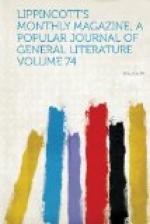Mrs. Wharton’s servants were first accused, but after a few days she was arrested, and with her daughter—who has clung throughout to her faith in her mother’s purity and goodness—was thrust into a common felon’s cell, with only the grated bars between her and the lowest of men in every stage of drunkenness and delirium. After nearly two weeks her lawyers obtained her removal to one of the better rooms of the jail, but it was months before anything was said in her favor.
The trial opened on December 4, 1871, at Annapolis, and lasted nearly two months. The circumstantial evidence certainly went no farther than to render it probable that if General Ketchum died of poison it was administered by Mrs. Wharton. The State attempted to prove as a motive that Mrs. Wharton owed the deceased money. They were signally unsuccessful in this, however; so that a very intelligent member of the jury said to the writer since the trial, “Whether Mrs. Wharton did or did not poison General Ketchum, certainly the State completely failed to prove a motive.” The defence admitted that Mrs. Wharton had bought tartar emetic near the time of the alleged poisoning, but proved that she was in the habit of using it externally as a counter-irritant, and that it was purchased in the most open manner, through a third party, not with the secresy that marks the steps of the poisoner.
Thus the whole case centred in a rather remarkable degree upon the expert testimony, and the very point of it all was the chemical analysis. This is not the place to follow out in detail the scientific testimony, but only to point out some peculiarities of it. Almost all the medical witnesses for the prosecution were colleagues of Professor Aiken, none of them men of eminence in toxicological science—surgeons, physiologists, obstetricians, the whole faculty, trying apparently to hide the nakedness of their colleague. Never was strong language more justifiable than that of Mr. Hagner, when he said, “It seemed that the University of Maryland was on trial, and that blood was demanded to support it.”
After all, the testimony of most of these gentlemen amounted only to this: that they did not believe the death of General Ketchum could have occurred from natural causes. On the other hand, the numerous medical witnesses for the defence, unconnected by any bond of common interest, testified that natural causes, were sufficient to account for the death; many of them asserting that the case in all its symptoms and post-mortem appearances tallied precisely with the so-called fulminating form of cerebro-spinal meningitis, which was prevalent in Baltimore at the time of General Ketchum’s death.[17]




